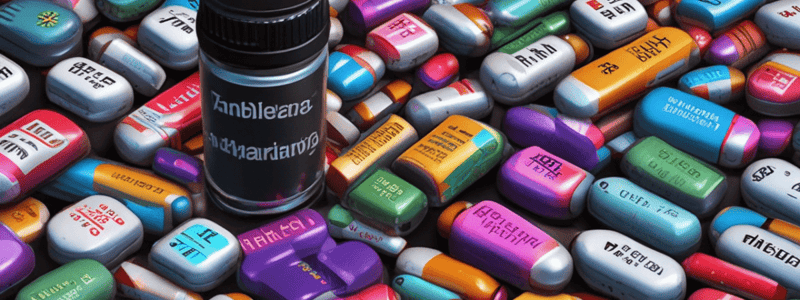Podcast
Questions and Answers
What is the primary reason the nurse practitioner needs to be alert for an energizing effect when prescribing tricyclic antidepressants (TCAs) for a patient with depression and suicidal ideation?
What is the primary reason the nurse practitioner needs to be alert for an energizing effect when prescribing tricyclic antidepressants (TCAs) for a patient with depression and suicidal ideation?
- The energizing effect may indicate the medication is not working effectively.
- The energizing effect may lead to increased physical activity and restlessness.
- The energizing effect may contribute to sufficient neurocognitive activation to follow through with a suicidal plan. (correct)
- The energizing effect may cause the patient to become more impulsive and reckless.
Which of the following is a common anticholinergic adverse effect associated with tricyclic antidepressants (TCAs)?
Which of the following is a common anticholinergic adverse effect associated with tricyclic antidepressants (TCAs)?
- Nausea and vomiting
- Drowsiness
- Dry mouth (correct)
- Orthostatic hypotension
Why should tricyclic antidepressants (TCAs) be used with extreme caution, if at all, in older adults?
Why should tricyclic antidepressants (TCAs) be used with extreme caution, if at all, in older adults?
- Older adults are more sensitive to the sedative effects of TCAs.
- Older adults are more likely to experience adverse drug interactions with TCAs.
- Older adults are more likely to experience weight gain as a side effect of TCAs.
- Due to their anticholinergic and norepinephrine effects, TCAs can contribute to confusion, orthostatic hypotension, and falls in older adults. (correct)
Which of the following is a significant drug interaction that can increase the plasma level of a tricyclic antidepressant (TCA) and the risk of cardiotoxicity?
Which of the following is a significant drug interaction that can increase the plasma level of a tricyclic antidepressant (TCA) and the risk of cardiotoxicity?
Which of the following tricyclic antidepressants (TCAs) is specifically noted for its efficacy in treating obsessive-compulsive disorder (OCD)?
Which of the following tricyclic antidepressants (TCAs) is specifically noted for its efficacy in treating obsessive-compulsive disorder (OCD)?
Which of the following is a common reason that some tricyclic antidepressants (TCAs) are more commonly used for insomnia than for depression?
Which of the following is a common reason that some tricyclic antidepressants (TCAs) are more commonly used for insomnia than for depression?
What is the potential effect of concurrent use of tricyclic antidepressants (TCAs) and monoamine oxidase inhibitors (MAOIs)?
What is the potential effect of concurrent use of tricyclic antidepressants (TCAs) and monoamine oxidase inhibitors (MAOIs)?
Which of the following tricyclic antidepressants (TCAs) is specifically mentioned as being useful for the treatment of neuropathic pain?
Which of the following tricyclic antidepressants (TCAs) is specifically mentioned as being useful for the treatment of neuropathic pain?
What is the recommended maximum daily dosage of amitriptyline (Elavil) for the treatment of depression in adults?
What is the recommended maximum daily dosage of amitriptyline (Elavil) for the treatment of depression in adults?
Which of the following drug interactions with tricyclic antidepressants (TCAs) can lead to increased prothrombin time?
Which of the following drug interactions with tricyclic antidepressants (TCAs) can lead to increased prothrombin time?
What neurotransmitters do Tricyclic Antidepressants (TCAs) act on?
What neurotransmitters do Tricyclic Antidepressants (TCAs) act on?
Why are Tricyclic Antidepressants (TCAs) considered less safe in treating depression in those at high risk for suicide?
Why are Tricyclic Antidepressants (TCAs) considered less safe in treating depression in those at high risk for suicide?
Which organ is primarily responsible for the first-pass metabolism of Tricyclic Antidepressants (TCAs)?
Which organ is primarily responsible for the first-pass metabolism of Tricyclic Antidepressants (TCAs)?
Why should Tricyclic Antidepressants (TCAs) be used with caution in patients with glaucoma?
Why should Tricyclic Antidepressants (TCAs) be used with caution in patients with glaucoma?
What is the primary reason Tricyclic Antidepressants (TCAs) are contraindicated in patients with cardiovascular disorders?
What is the primary reason Tricyclic Antidepressants (TCAs) are contraindicated in patients with cardiovascular disorders?
Which Pregnancy Category are Tricyclic Antidepressants (TCAs) classified under?
Which Pregnancy Category are Tricyclic Antidepressants (TCAs) classified under?
What common side effect is associated with abrupt discontinuance of Tricyclic Antidepressants (TCAs)?
What common side effect is associated with abrupt discontinuance of Tricyclic Antidepressants (TCAs)?
Which of the following neurotransmitters does Loxapine, an active metabolite of amoxapine, act on?
Which of the following neurotransmitters does Loxapine, an active metabolite of amoxapine, act on?
What effect do Tricyclic Antidepressants (TCAs) have on cardiac conduction?
What effect do Tricyclic Antidepressants (TCAs) have on cardiac conduction?
Why are baseline ECG and periodic monitoring recommended when prescribing Tricyclic Antidepressants (TCAs)?
Why are baseline ECG and periodic monitoring recommended when prescribing Tricyclic Antidepressants (TCAs)?
What is the maximum daily dose of amoxapine (Asendin) for adults and children over 16 years old?
What is the maximum daily dose of amoxapine (Asendin) for adults and children over 16 years old?
For clomipramine (Anafranil) in children and adolescents, what is the maximum daily dose?
For clomipramine (Anafranil) in children and adolescents, what is the maximum daily dose?
What is the maximum daily dose of desipramine HCl (Norpramin) for adults?
What is the maximum daily dose of desipramine HCl (Norpramin) for adults?
Which of the following is NOT an indication for the use of tricyclic antidepressants (TCAs)?
Which of the following is NOT an indication for the use of tricyclic antidepressants (TCAs)?
What information should be obtained prior to prescribing TCAs, according to the text?
What information should be obtained prior to prescribing TCAs, according to the text?
What should be done with older adults when prescribing TCAs?
What should be done with older adults when prescribing TCAs?
What monitoring should be done when prescribing TCAs?
What monitoring should be done when prescribing TCAs?
What should be monitored carefully during the first month after initiating TCAs?
What should be monitored carefully during the first month after initiating TCAs?
If a patient develops dry mouth while taking TCAs, what should be advised?
If a patient develops dry mouth while taking TCAs, what should be advised?
If constipation develops while taking TCAs, what should be advised?
If constipation develops while taking TCAs, what should be advised?
What are the five main classes of antidepressants identified in the text?
What are the five main classes of antidepressants identified in the text?
Which age group is most likely to experience an increased risk of suicidal thoughts and behavior when taking antidepressants?
Which age group is most likely to experience an increased risk of suicidal thoughts and behavior when taking antidepressants?
What is the primary mechanism of action for the novel antidepressants ketamine and LY3020371 described in the text?
What is the primary mechanism of action for the novel antidepressants ketamine and LY3020371 described in the text?
What is the main reason the text emphasizes for monitoring patients closely for suicidal ideation and behavior when prescribing antidepressants?
What is the main reason the text emphasizes for monitoring patients closely for suicidal ideation and behavior when prescribing antidepressants?
What is the current status of the novel antidepressant LY3020371 described in the text?
What is the current status of the novel antidepressant LY3020371 described in the text?
What is the primary route of administration for ketamine when used as an antidepressant?
What is the primary route of administration for ketamine when used as an antidepressant?
Flashcards are hidden until you start studying




